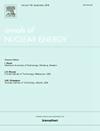Improved CFD modeling of radial void fraction distribution in flow boiling: A novel approach for wide-ranging operating conditions
IF 1.9
3区 工程技术
Q1 NUCLEAR SCIENCE & TECHNOLOGY
引用次数: 0
Abstract
Accurate prediction of void fraction distribution in flow boiling is of great significance for the thermal–hydraulic analysis and safety of nuclear power plants. Computational Fluid Dynamics (CFD) methods have consistently proven to be effective for boiling simulation. Due to the complexity of boiling phenomena, the prediction of radial void fraction distribution in tubes tends to be challenging, thus hindering a clear understanding of the underlying mechanism. In this work, with the aim of achieving the void fraction prediction over a wide range, the DEBORA experiment operated with R12 was simulated within the pressure range of 1.46–3 MPa and the mass flux range of 1000–5000 kg·m−2·s−1. The closures of the two-phase equation were compared and the applicability of R12 was discussed. Meanwhile, sensitivity analyses were conducted on the models for bubble departure diameter, lift force, and turbulent dispersion force. The Kocamustafaogullari model was selected for calculating bubble departure diameter. According to the cross-sectional average void fraction, the appropriate selection criteria for the effective turbulent Prandtl number model was recommended. An abnormal upward trend of void fraction near the wall was observed for G ≥ 3000 kg·m−2·s−1 due to the small or even negative relative velocity rather than the lift force coefficient model. A new lift force coefficient model relevant to pressure, mass flux, and void fraction has been proposed. The new CFD model combination demonstrated a good agreement with the experiment, providing an effective tool for analyzing the radial void fraction distribution.
流动沸腾中径向空隙率分布的改进CFD建模:一种适用于广泛工况的新方法
流动沸腾过程中空隙率分布的准确预测对核电厂的热工分析和安全运行具有重要意义。计算流体动力学(CFD)方法已被证明是有效的沸腾模拟。由于沸腾现象的复杂性,对管内径向空隙率分布的预测往往具有挑战性,从而阻碍了对其潜在机制的清晰认识。为了实现更大范围的孔隙率预测,在1.46 ~ 3 MPa的压力范围和1000 ~ 5000 kg·m−2·s−1的质量通量范围内,采用R12对DEBORA实验进行了模拟。比较了两相方程的闭包,讨论了R12的适用性。同时,对气泡偏离直径、升力和湍流弥散力模型进行了敏感性分析。选取Kocamustafaogullari模型计算气泡偏离直径。根据横截面平均空隙率,推荐了合适的有效湍流普朗特数模型的选择准则。当G≥3000 kg·m−2·s−1时,由于相对速度较小甚至为负,而不是由于升力系数模型,壁面附近的空隙率呈异常上升趋势。提出了一种与压力、质量流量和空隙率相关的升力系数模型。新的CFD模型组合与实验结果吻合较好,为分析径向含气率分布提供了有效工具。
本文章由计算机程序翻译,如有差异,请以英文原文为准。
求助全文
约1分钟内获得全文
求助全文
来源期刊

Annals of Nuclear Energy
工程技术-核科学技术
CiteScore
4.30
自引率
21.10%
发文量
632
审稿时长
7.3 months
期刊介绍:
Annals of Nuclear Energy provides an international medium for the communication of original research, ideas and developments in all areas of the field of nuclear energy science and technology. Its scope embraces nuclear fuel reserves, fuel cycles and cost, materials, processing, system and component technology (fission only), design and optimization, direct conversion of nuclear energy sources, environmental control, reactor physics, heat transfer and fluid dynamics, structural analysis, fuel management, future developments, nuclear fuel and safety, nuclear aerosol, neutron physics, computer technology (both software and hardware), risk assessment, radioactive waste disposal and reactor thermal hydraulics. Papers submitted to Annals need to demonstrate a clear link to nuclear power generation/nuclear engineering. Papers which deal with pure nuclear physics, pure health physics, imaging, or attenuation and shielding properties of concretes and various geological materials are not within the scope of the journal. Also, papers that deal with policy or economics are not within the scope of the journal.
 求助内容:
求助内容: 应助结果提醒方式:
应助结果提醒方式:


